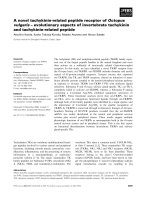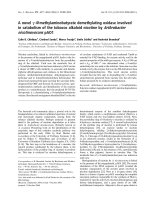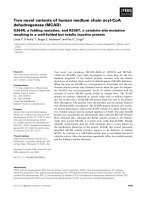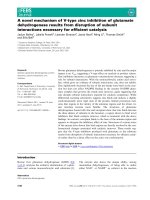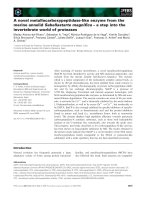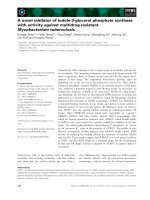báo cáo khoa học: "A novel method of cultivating cardiac myocytes in agarose microchamber chips for studying cell synchronization" ppt
Bạn đang xem bản rút gọn của tài liệu. Xem và tải ngay bản đầy đủ của tài liệu tại đây (376.24 KB, 4 trang )
BioMed Central
Page 1 of 4
(page number not for citation purposes)
Journal of Nanobiotechnology
Open Access
Short Communication
A novel method of cultivating cardiac myocytes in agarose
microchamber chips for studying cell synchronization
Kensuke Kojima, Tomoyuki Kaneko and Kenji Yasuda*
Address: Department of Life Sciences, Graduate school of Arts and Sciences, University of Tokyo, 3-8-1 Komaba, Meguro, Tokyo 153-8902 JAPAN
Email: Kensuke Kojima - ; Tomoyuki Kaneko - ;
Kenji Yasuda* -
* Corresponding author
Abstract
We have developed a new method that enables agar microstructures to be used to cultivate cardiac
myocyte cells in a manner that allows their connection patterns to be controlled. Non-contact
three-dimensional photo-thermal etching with a 1064-nm infrared focused laser beam was used to
form the shapes of agar microstructures. This wavelength was selected as it is not absorbed by
water or agar. Identical rat cardiac myocytes were cultured in adjacent microstructures connected
by microchannels and the interactions of asynchronous beating cardiac myocyte cells observed.
Two isolated and independently beating cardiac myocytes were shown to form contacts through
the narrow microchannels and by 90 minutes had synchronized their oscillations. This occurred by
one of the two cells stopping their oscillation and following the pattern of the other cell. In contrast,
when two sets of synchronized beating cells came into contact, those two sets synchronized
without any observable interruptions to their rhythms. The results indicate that the
synchronization process of cardiac myocytes may be dependent on the community size and
network pattern of these cells.
Finding
Single-cell based analysis methods have become more
and more important for understanding the cell-group
effects such as how information is controlled and
recorded in a cell group or a network shape. Early tissue
culture studies of cardiac myocyte cells demonstrated that
a single beating cell can influence the rate of a neighbour-
ing cell in close contact and that a group of heart cells in a
culture, beating synchronously with a rapid rhythm, can
act as pacemaker for a contiguous cell sheet [1]. Though
the former results predicted that a rapidly beating region
of tissue acts as pacemaker for a slower one and examined
how the synchronization process of two isolated beating
cardiac myocytes [2], the cell-to-cell connection could not
be controlled completely without using microstructures
on the cultivation plate. As means of attaining the spatial
arrangement of cardiac myocytes, we have developed a
new single-cell cultivation method and a system using
agar microstructures, based on 1064-nm photo-thermal
etching [3-6]. We have also developed the on-chip single-
cell sorting method for cultivating particular cells chosen
from clued mixture of cells [7], and have found the adap-
tation process of epigenetic memorization in cells by stor-
ing the information as the localization of proteins [8].
This paper reports the practical use of the agar chamber for
screening the community size effect of the synchroniza-
tion process of adjacent cardiac myocyte cells having inde-
pendent oscillation.
Published: 09 September 2004
Journal of Nanobiotechnology 2004, 2:9 doi:10.1186/1477-3155-2-9
Received: 20 December 2003
Accepted: 09 September 2004
This article is available from: />© 2004 Kojima et al; licensee BioMed Central Ltd.
This is an open-access article distributed under the terms of the Creative Commons Attribution License ( />),
which permits unrestricted use, distribution, and reproduction in any medium, provided the original work is properly cited.
Journal of Nanobiotechnology 2004, 2:9 />Page 2 of 4
(page number not for citation purposes)
Figure 1 shows the schematic drawing of the agar micro-
chambers on the chip. The microchambers and micro-
channels were constructed by localized melting of a
portion of the 5-µm-thick agar layer using a 1064-nm the
infrared focused laser beam, a process we have termed
photo-thermal etching. The 1064-nm laser beam is not
absorbed by either water or the agar, and selectively melts
a portion of the agar just near the chromium thin layer as
this layer absorbs the beam energy. Microstructures such
as holes and channels can be easily produced using this
non-contact etching within only a few minutes without
the requirement of any cast moulding process. The melt-
ing of agar by laser occurred as follows: (a) the 1064-nm
infrared laser beam was focused on the agar layer on the
glass slide; (b) the agar at the focal point and on the light
pathway started to melt; (c) when the focused beam was
moved parallel to the chip surface, a portion of agar
around the focal spot of laser melted and diffused into
water; (d) after the heated spot had been moved, a chan-
nel was created at the bottom of the agar layer connecting
the two adjacent holes. The microscope confirmed the
melting had occurred, and then either the heating was
continued until the spot size reached the desired size, or
the heating position was shifted to achieve the desired
shape. Cardiac myocytes were cultivated in each hole of
the agar microchambers on the chip as shown in Fig. 1.
Collagen-type I (Nitta gelatin, Osaka, Japan) was coated
on the glass layer surface to improve the attachment of the
cell to the bottom of the microchambers.
Neonatal rat cardiac myocytes were isolated and purified
as follows. First, the hearts of 1- to 3-day-old Wistar rats
(Nippon Bio-supp. Center, Tokyo, Japan) were excised
under ether anaesthesia. The ventricles were separated
from the atria and then washed with phosphate buffered
saline (PBS, 137 mM NaCl, 2.7 mM KCl, 8 mM Na
2
HPO
4
,
1.5 mM KH
2
PO
4
, pH 7.4) containing 0.9 mM CaCl
2
and
0.5 mM MgCl
2
. The ventricles were minced in PBS with-
out CaCl
2
or MgCl
2
and then incubated in PBS containing
0.25% collagenase (Wako, Osaka, Japan) for 30 minutes
at 37°C to digest the ventricular tissue. This procedure
was repeated twice more and the cell suspension was then
transferred to cell culture medium (DMEM [Invitrogen
Corp., Carlsbad, CA USA] supplemented with 10% fetal
bovine serum, 100 U/ml penicillin, and 100 µg/ml Strep-
tomycin) at 4°C. The cells were filtered through a 40-µm
nylon mesh and centrifuged at 180 g for 5 minutes at
room temperature. The cell pellet was re-suspended in a
HEPES buffer (20 mM HEPES, 110 mM NaCl, 1 mM
NaH
2
PO
4
, 5 mM glucose, 5 mM KCl, and 1 mM MgSO
4
,
pH 7.4). Cardiac myocytes present in the suspension were
separated from other cells (i.e., fibroblasts and endothe-
lial cells) by the density centrifugation method. The cell
suspension was then layered onto 40.5% Percoll (Amer-
sham Biosciences, Uppsala, Sweden) diluted in the
HEPES buffer, which had previously been layered onto
58.5% Percoll diluted in the same buffer. The cell suspen-
sion was then centrifuged at 2200 g for 30 minutes at
room temperature. Cardiac myocytes were retrieved from
the interface of the 40.5% and 58.5% Percoll layers.
Retrieved cells were then re-suspended in the cell culture
medium. An aliquot (5- µl) of the suspension was diluted
to achieve a final concentration of 3.0 × 10
5
cells/ml then
plated into the chip. Individual cardiac myocytes were
picked up by a micropipette and manually introduced
into each chip microchamber and incubated on a cell-cul-
tivation microscope system at 37°C in the presence of a
humidified atmosphere of 95% air /5% CO
2
. It should be
noted that because the microchamber sidewalls were
made of agar, then the cells could not easily pass over the
chambers.
Phase-contrast microscopy was used to measure the con-
traction rhythm of the cardiac myocytes and the network
formation of cells in the two adjacent chambers that were
connected by the focused beam.
The spontaneous contraction rhythm of cultured cardiac
myocytes was evaluated by a video-image recording
method. Images of beating cardiac myocytes were
recorded with a CCD camera through the use of a phase
contrast microscope. The sizes (cross-section of volume)
of cardiac myocytes, which changed considerably with
contraction, were also analyzed and recorded every 1/30 s
by a personal computer with a video capture board.
Figure 1 shows a micrograph image of two isolated, inde-
pendently beating cardiac myocytes coming into contact
through the microchannel. Ninety min after the physical
contact, the two connected cells started to oscillate syn-
chronously. The time course change of the heart beating
was as shown in Fig. 1. As shown in the graph, the process
of synchronization was accomplished only after one of
the cells stopped beating and then synchronized its oscil-
lation with other cell. Movie 1 (see additional file 1
"movie1.mpg") depicts the process of beating synchroni-
zation. Once the synchronized oscillation of the two cells
was accomplished (arrowhead in Fig. 1), then the two
cells maintained synchronization similar to that observed
in whole tissue. A time interval of approximately 90 min
was needed to form the gap junction between the two
adjacent cells.
The same method was also used to make more compli-
cated network patterns of cardiac myocytes. Figure 1
shows a micrograph of a four-cell network. As shown in
the graph (Fig. 1), two sets of the beating pairs synchro-
nized without having to stop unlike that previously
observed for the synchronization of isolated cells (see 1).
This suggests that the synchronization dynamics and
Journal of Nanobiotechnology 2004, 2:9 />Page 3 of 4
(page number not for citation purposes)
(A): Schematic drawing of the on-chip agar cultivation assayFigure 1
(A): Schematic drawing of the on-chip agar cultivation assay. (B): Optical micrograph of 24-h cultivation of two cardiac myocyte
cells. (C): Time-course of oscillation of cardiac myocytes shown in Fig. (B). (D): Optical micrograph of 24-h cultivation of two
sets of the synchronized pairs. (E): Time-course of oscillation of cardiac myocytes shown in Fig. (D).
Publish with BioMed Central and every
scientist can read your work free of charge
"BioMed Central will be the most significant development for
disseminating the results of biomedical research in our lifetime."
Sir Paul Nurse, Cancer Research UK
Your research papers will be:
available free of charge to the entire biomedical community
peer reviewed and published immediately upon acceptance
cited in PubMed and archived on PubMed Central
yours — you keep the copyright
Submit your manuscript here:
/>BioMedcentral
Journal of Nanobiotechnology 2004, 2:9 />Page 4 of 4
(page number not for citation purposes)
rhythm of the cell group is more stable than that of single
cells.
In conclusion, we present a 1064-nm photo-thermal etch-
ing technology with which to create agarose microcham-
bers for growing networks of cardiac myocyte cells. Using
the system, we first observed the differences of the syn-
chronization process of cardiac myocyte cells and their
dependence on community size. This system has great
potential for use in the biological/medical fields for culti-
vating the next stage of single-cell based networks and
measuring their properties in laboratories.
Authors' contributions
KK and TK carried out the microchamber design, cell prep-
aration, single cell cultivation and observation, image
analysis. Both authors contributed equally to this article.
KY conceived of the study, and participated in its design
and coordination. All authors read and approved the final
manuscript.
Additional material
References
1. Harary I, Farley B: In vitro studies on single beating rat heart
cells. II. Intercellular communication. Exp Cell Res 1963,
29:466-474.
2. DeHaan RL, Hirakow R: Synchronization of pulsation rates in
isolated cardiac myocytes. Exp Cell Res 1972, 70:214-220.
3. Moriguchi H, Wakamoto Y, Sugio Y, Takahashi K, Inoue I, Yasuda Y:
An agar-microchamber cell-cultivation system: flexible
change of microchamber shapes during cultivation by photo-
thermal etching. Lab Chip 2002, 2:125-30.
4. Moriguchi H, Takahashi K, Sugio Y, Wakamoto Y, Inoue I, Jimbo Y,
Yasuda K: On chip neural cell cultivation using agarose-micro-
chamber array constructed by photo-thermal etching
method. Electrical Engineering in Japan 2003, 146:37-42.
5. Kojima K, Moriguchi H, Hattori A, Kaneko T, Yasuda K: Two-
dimensional network formation of cardiac myocytes in agar
microculture chip with 1480-nm infrared laser photo-ther-
mal etching. Lab Chip 2003, 3:299-303.
6. Suzuki I, Sugio Y, Moriguchi H, Jimbo Y, Yasuda K: Modification of
a neuronal network direction using stepwise photo-thermal
etching of an agarose architecture. J Nanobiotechnology 2004,
2:7.
7. Takahashi K, Hattori A, Suzuki I, Ichiki T, Yasuda K: Non-destruc-
tive on-chip cell sorting system with real-time microscopic
image processing. J Nanobiotechnology 2004, 2:5.
8. Inoue I, Shiomi D, Kawagishi I, Yasuda K: Simultaneous measure-
ment of sensor-protein dynamics and motility of a single cell
by on-chip microcultivation system. J Nanobiotechnology 2004,
2:4.
Additional File 1
two cells. synchronized oscillation of the two cells
Click here for file
[ />3155-2-9-S1.mpg]
Additional File 2
two sets of cells. synchronized oscillation of the two sets of cells
Click here for file
[ />3155-2-9-S2.mpg]


